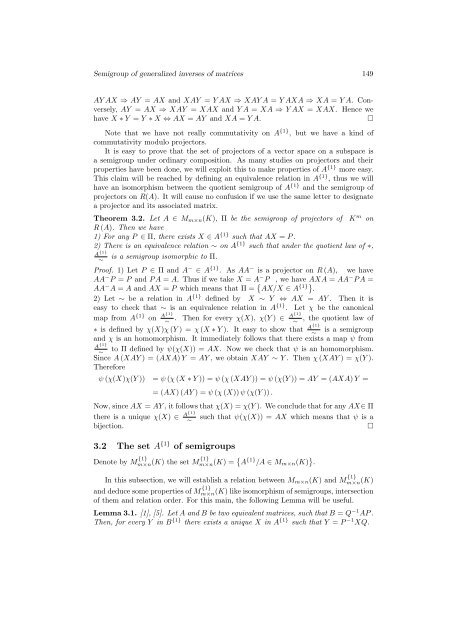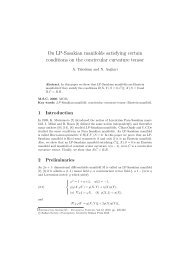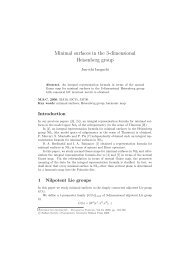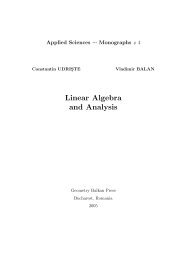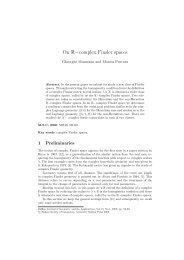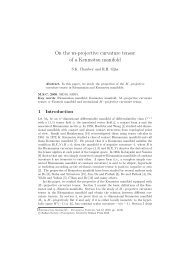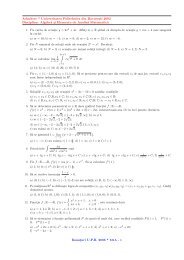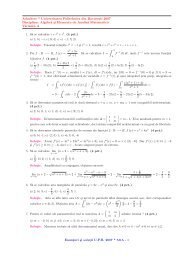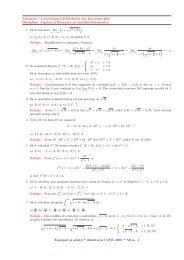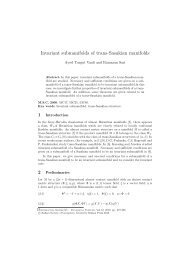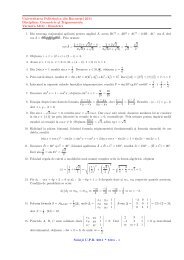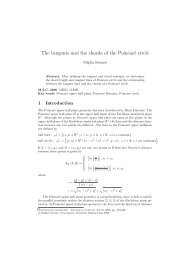Semigroup of generalized inverses of matrices
Semigroup of generalized inverses of matrices
Semigroup of generalized inverses of matrices
Create successful ePaper yourself
Turn your PDF publications into a flip-book with our unique Google optimized e-Paper software.
<strong>Semigroup</strong> <strong>of</strong> <strong>generalized</strong> <strong>inverses</strong> <strong>of</strong> <strong>matrices</strong> 149AY AX ⇒ AY = AX and XAY = Y AX ⇒ XAY A = Y AXA ⇒ XA = Y A. Conversely,AY = AX ⇒ XAY = XAX and Y A = XA ⇒ Y AX = XAX. Hence wehave X ∗ Y = Y ∗ X ⇔ AX = AY and XA = Y A.□Note that we have not really commutativity on A {1} , but we have a kind <strong>of</strong>commutativity modulo projectors.It is easy to prove that the set <strong>of</strong> projectors <strong>of</strong> a vector space on a subspace isa semigroup under ordinary composition. As many studies on projectors and theirproperties have been done, we will exploit this to make properties <strong>of</strong> A {1} more easy.This claim will be reached by defining an equivalence relation in A {1} , thus we willhave an isomorphism between the quotient semigroup <strong>of</strong> A {1} and the semigroup <strong>of</strong>projectors on R(A). It will cause no confusion if we use the same letter to designatea projector and its associated matrix.Theorem 3.2. Let A ∈ M m×n (K), Π be the semigroup <strong>of</strong> projectors <strong>of</strong> K m onR (A). Then we have1) For any P ∈ Π, there exists X ∈ A {1} such that AX = P .2) There is an equivalence relation ∼ on A {1} such that under the quotient law <strong>of</strong> ∗,is a semigroup isomorphic to Π.A {1}∼Pro<strong>of</strong>. 1) Let P ∈ Π and A − ∈ A {1} . As AA − is a projector on R (A), we haveAA − P = P and P A = A. Thus if we take X = A − P , we have AXA = AA − P A =AA − A = A and AX = P which means that Π = { AX/X ∈ A {1}} .2) Let ∼ be a relation in A {1} defined by X ∼ Y ⇔ AX = AY . Then it iseasy to check that ∼ is an equivalence relation in A {1} . Let χ be the canonicalmap from A {1} on A{1}A{1}∼. Then for every χ(X), χ(Y ) ∈∼, the quotient law <strong>of</strong>∗ is defined by χ(X)χ (Y ) = χ (X ∗ Y ). It easy to show that A{1}∼is a semigroupand χ is an homomorphism. It immediately follows that there exists a map ψ fromA {1}∼to Π defined by ψ(χ(X)) = AX. Now we check that ψ is an homomorphism.Since A (XAY ) = (AXA) Y = AY , we obtain XAY ∼ Y . Then χ (XAY ) = χ(Y ).Thereforeψ (χ(X)χ(Y )) = ψ (χ (X ∗ Y )) = ψ (χ (XAY )) = ψ (χ(Y )) = AY = (AXA) Y == (AX) (AY ) = ψ (χ (X)) ψ (χ(Y )) .Now, since AX = AY , it follows that χ(X) = χ(Y ). We conclude that for any AX∈ Πthere is a unique χ(X) ∈ A{1}∼such that ψ(χ(X)) = AX which means that ψ is abijection.□3.2 The set A {1} <strong>of</strong> semigroupsDenote by M {1}m×n(K) the set M {1}m×n(K) = { A {1} /A ∈ M m×n (K) } .In this subsection, we will establish a relation between M m×n (K) and M m×n(K){1}and deduce some properties <strong>of</strong> M m×n(K) {1} like isomorphism <strong>of</strong> semigroups, intersection<strong>of</strong> them and relation order. For this main, the following Lemma will be useful.Lemma 3.1. [1], [5]. Let A and B be two equivalent <strong>matrices</strong>, such that B = Q −1 AP .Then, for every Y in B {1} there exists a unique X in A {1} such that Y = P −1 XQ.


